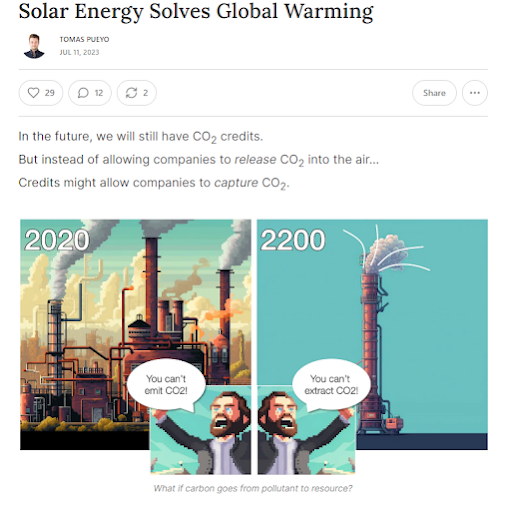You may remember Tomas Pueyo, the man who forced us into lockdowns with his idea that we needed "Two Weeks to Flatten the Curve." His post on this subject is said to have generated some 40 million visualizations! Then, as we know, the two weeks turned into two years, and the curve was not flattened (I describe the story in detail in this post of mine).
Now, Pueyo is back with another idea, this time about how to "solve" Global Warming. Simple: capture CO2, turn it into methane, burn it as fuel. Problem solved. Maybe not in two weeks, but quickly and easily. And making money on it, too!
I think Pueyo is a well-intentioned person. It is just that he has problems with connecting dreams to reality. His approach is typically "political;" it is the search for simple solutions to complex problems. With the "flattening the curve" idea based on strict lockdowns, Pueyo was proposing a major social disruption on the basis of two hand-drawn curves with scarcely any data supporting it. Incredibly, he succeeded in having his proposal experimented worldwide. The hope that the Covid problem could be solved in two weeks was so fascinating for politicians, and the public as well, that everyone jumped into the barrel heading for the Niagara Falls.
This time, Pueyo does a little better, and, at least his "solution" for global warming doesn't involve locking us inside our homes again (so far, at least). But his paper is a rambling mix of unoriginal and unproven ideas. At least on one thing, though, Pueyo is right: the dramatic decline of energy prices generated by renewable makes it possible to think of things that were unthinkable just a few years ago.
As we know, renewable energy is very cheap, but it has a problem: matching demand. That, in principle, requires storage and there are several ideas and possibilities to do that. Several years ago, in the 1990s, George Olah proposed a "methanol-based economy" (see this article published in 2005). The idea was to react CO2 and hydrogen with each other to create methanol (methyl alcohol). Since CO2 can be extracted from the atmosphere, and hydrogen can be created from the electrolysis of water, it is possible to run the process by means of renewable energy. The result is a fuel, methanol, that is completely renewable. Methanol is liquid at room temperature, so it is easy to store and transport, and it could work wonders both as fuel and as an energy storage system.
In time, Olah's ideas have been incorporated into the more general idea of "electrofuels." The idea is the same, but arcane catalytic chemistry is used to create, for instance, "renewable gasoline" and "renewable diesel fuel." It is possible, even though, at present, there only exist hopes and a few prototype plants.
The problems with electrofuels are several. One is simply a question of cost: making renewable hydrogen from electrolysis is already expensive enough that it is not cost-competitive with simpler energy storage solutions, such as batteries. Then, CO2 exists in air as less than one part in a thousand, so it takes a lot of energy and effort to extract and concentrate it. Consider also that conventional engines are hugely inefficient, and running them on electrofuels doesn't improve that. Finally, the problems with the pollution caused by combustion in engines remain unchanged. Right now, electrofuels are neither cost-competitive nor able to reduce pollution. But they might be useful for specific needs; planes, for instance.
Now, back to Pueyo, he proposes to use renewable energy not to make electrofuels but plain, simple methane (natural gas). The idea is not commonly discussed in the debate mostly because liquid electrofuels are much more valuable than gaseous methane, and so their production is expected to be more cost-effective. Of course, an advantage of renewable methane would be that we could use the already existing pipelines and cryogenic ships to transport it (and no, hydrogen cannot flow through the existing pipelines). But if methane is created from renewable energy, then it can be produced more or less anywhere, and there would be little need for a huge network of pipelines.
Basically, what Pueyo is doing is making a sales pitch for a company called "Terraform Industries" which has published on the Web some nice-looking sketches of what a renewable methane plant could look like. They also published some back-of-the-envelope calculations of how much this methane could cost (maybe), and claims that production should soon start.
Alas, dreams tend to shatter into tiny pieces when hitting the ugly reality. Turning CO2 into methane is not impossible, but it is inefficient, expensive, and complicated, even when taking into account the low cost of solar energy. Right now, it is more expensive than just about any other form of renewable energy and would simply keep us stuck to an inefficient and polluting energy system. Then, in itself, making methane from CO2 is not doing much to "solve global warming" (to use Pueyo's wording). True, it does not add CO2 to the existing stock in the atmosphere, but unavoidable methane leaks from the plants could do a lot of damage since methane is a much stronger greenhouse gas than CO2.
Unfortunately, Pueyo's post is perpetuating the idea that those who push for renewable energy are just dreamers who have little contact with reality. We have to be open to new technological solutions as they appear, but electrofuels are not a miracle solution for anything. We should always keep in mind that moving to renewable energy is not going to be easy, nor it is going to be cheap. But not impossible, either!
h/t Olivier Guyot



No comments:
Post a Comment